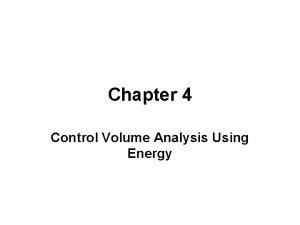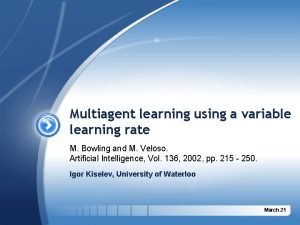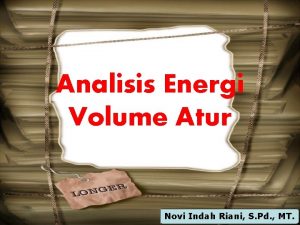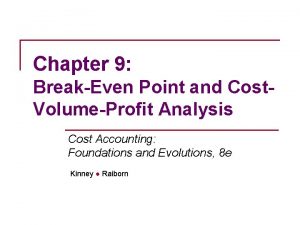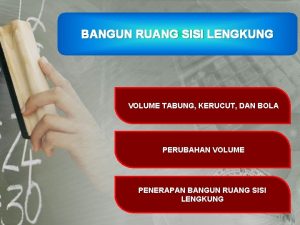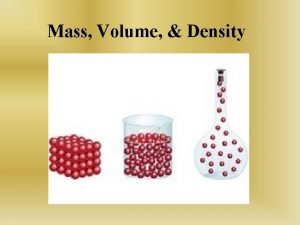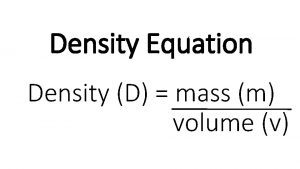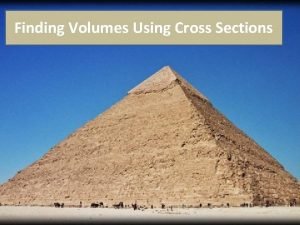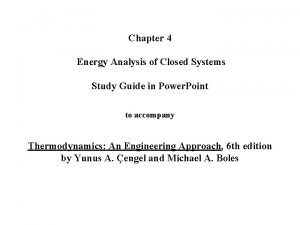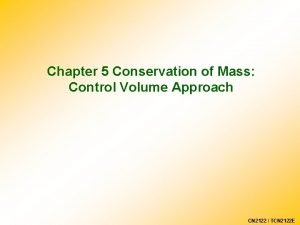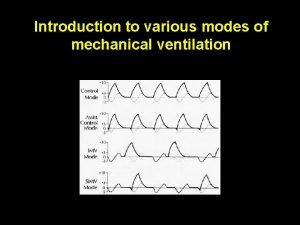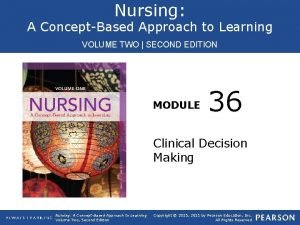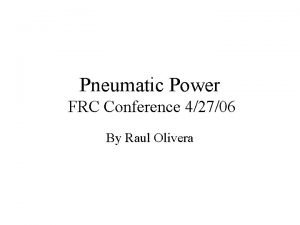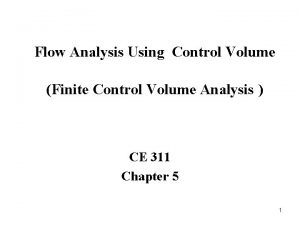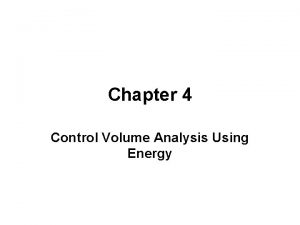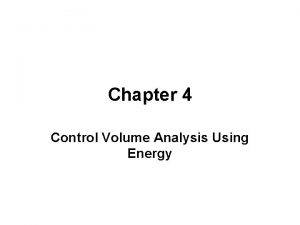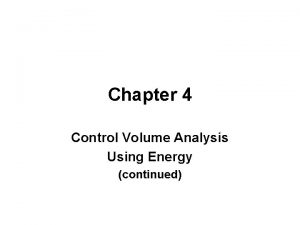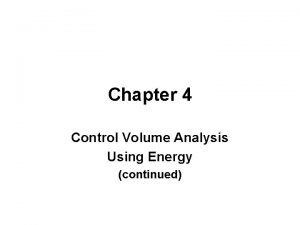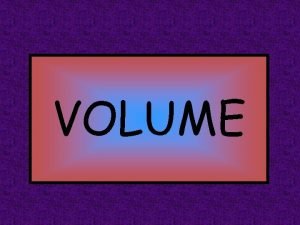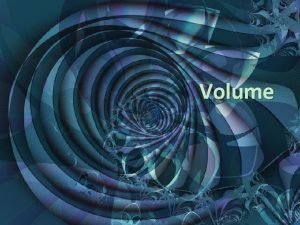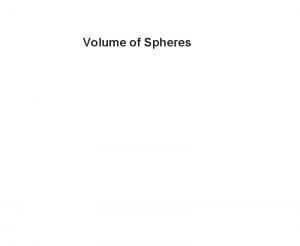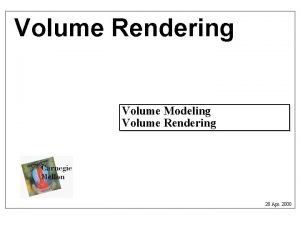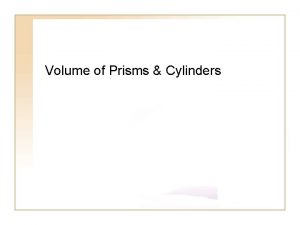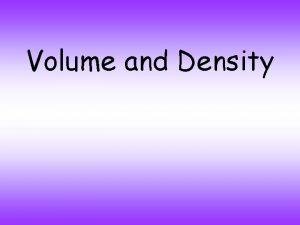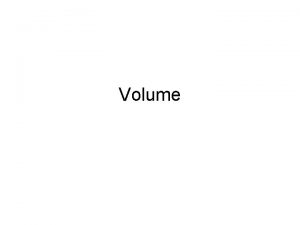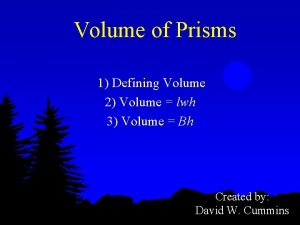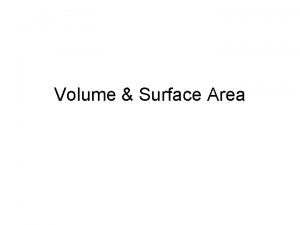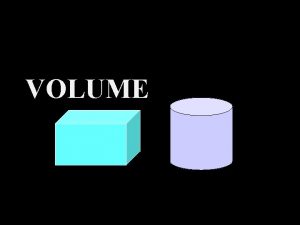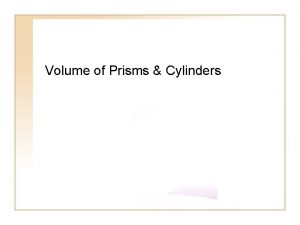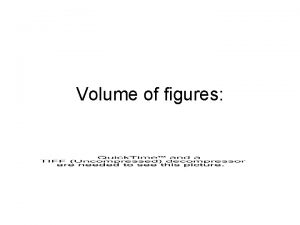Chapter 4 Control Volume Analysis Using Energy Learning

































- Slides: 33

Chapter 4 Control Volume Analysis Using Energy

Learning Outcomes ►Demonstrate understanding of key concepts related to control volume analysis including distinguishing between steady-state and transient analysis, distinguishing between mass flow rate and volumetric flow rate, and the meanings of one-dimensional flow and flow work. ►Apply mass and energy balances to control volumes.

Learning Outcomes, cont. ►Develop appropriate engineering models for control volumes, with particular attention to analyzing components commonly encountered in engineering practice such as nozzles, diffusers, turbines, compressors, heat exchangers, throttling devices, and integrated systems that incorporate two or more components. ►Use property data in control volume analysis appropriately.

Mass Rate Balance time rate of change of mass contained within the control volume at time rate of flow of mass in across inlet i at time rate of flow of mass out across exit e at time t (Eq. 4. 1)

Mass Rate Balance In practice there may be several locations on the boundary through which mass enters or exits. Multiple inlets and exits are accounted for by introducing summations: (Eq. 4. 2) Eq. 4. 2 is the mass rate balance for control volumes with several inlets and exits.

Mass Flow Rate (One-Dimensional Flow) ►Flow is normal to the boundary at locations where mass enters or exits the control volume. ►All intensive properties are uniform with position over each inlet or exit area (A) through which matter flows. (Eq. 4. 4 b) where V is velocity v is specific volume

Mass Rate Balance (Steady-State Form) ►Steady-state: all properties are unchanging in time. ►For steady-state control volume, dmcv/dt = 0. (Eq. 4. 6) (mass rate in) (mass rate out)

Energy Rate Balance time rate of change of the energy contained within the control volume at time t net rate at which energy is being transferred in by heat transfer at time t net rate at which energy is being transferred out by work at time t net rate of energy transfer into the control volume accompanying mass flow (Eq. 4. 9)

Evaluating Work for a Control Volume The expression for work is (Eq. 4. 12) where ► accounts for work associated with rotating shafts, displacement of the boundary, and electrical effects. ► is the flow work at exit e. ► is the flow work at inlet i.

Control Volume Energy Rate Balance (One-Dimensional Flow Form) Using Eq. 4. 12 in Eq. 4. 9 (Eq. 4. 13) For convenience substitute enthalpy, h = u + pv (Eq. 4. 14)

Control Volume Energy Rate Balance (One-Dimensional Flow Form) In practice there may be several locations on the boundary through which mass enters or exits. Multiple inlets and exits are accounted for by introducing summations: (Eq. 4. 15) Eq. 4. 15 is the accounting balance for the energy of the control volume.

Control Volume Energy Rate Balance (Steady-State Form) ►Steady-state: all properties are unchanging in time. ►For steady-state control volume, d. Ecv/dt = 0. (Eq. 4. 18)

Control Volume Energy Rate Balance (Steady-State Form, One-Inlet, One-Exit) ►Many important applications involve one-inlet, one-exit control volumes at steady state. ►The mass rate balance reduces to . Eq. 4. 20 a or dividing by mass flow rate Eq. 4. 20 b

Nozzles and Diffusers ►Nozzle: a flow passage of varying crosssectional area in which the velocity of a gas or liquid increases in the direction of flow. ►Diffuser: a flow passage of varying crosssectional area in which the velocity of a gas or liquid decreases in the direction of flow.

Nozzle and Diffuser Modeling Eq. 4. 20 a ► ►If the change in potential energy from inlet to exit is negligible, g(z 1 – z 2) drops out. ►If the heat transfer with surroundings is negligible, drops out. (Eq. 4. 21)

Turbines ►Turbine: a device in which power is developed as a result of a gas or liquid passing through a set of blades attached to a shaft free to rotate.

Turbine Modeling Eq. 4. 20 a ►If the change in kinetic energy of flowing matter is negligible, ½(V 12 – V 22) drops out. ►If the change in potential energy of flowing matter is negligible, g(z 1 – z 2) drops out. ►If the heat transfer with surroundings is negligible, drops out.

Compressors and Pumps ►Compressors and Pumps: devices in which work is done on the substance flowing through them to change the state of the substance, typically to increase the pressure and/or elevation. ►Compressor : substance is gas ►Pump: substance is liquid

Compressor and Pump Modeling Eq. 4. 20 a ►If the change in kinetic energy of flowing matter is negligible, ½(V 12 – V 22) drops out. ►If the change in potential energy of flowing matter is negligible, g(z 1 – z 2) drops out. ►If the heat transfer with surroundings is negligible, drops out.

Heat Exchangers ►Direct contact: A mixing chamber in which hot and cold streams are mixed directly. ►Tube-within-a-tube counterflow: A gas or liquid stream is separated from another gas or liquid by a wall through which energy is conducted. Heat transfer occurs from the hot stream to the cold stream as the streams flow in opposite directions.

Heat Exchanger Modeling (Eq. 4. 18) ► ►If the kinetic energies of the flowing streams are negligible, (Vi 2/2) and (Ve 2/2) drop out. ►If the potential energies of the flowing streams are negligible, gzi and gze drop out. ►If the heat transfer with surroundings is negligible, drops out.

Throttling Devices ►Throttling Device: a device that achieves a significant reduction in pressure by introducing a restriction into a line through which a gas or liquid flows. Means to introduce the restriction include a partially opened valve or a porous plug.

Throttling Device Modeling Eq. 4. 20 a ► ►If the change in kinetic energy of flowing matter upstream and downstream of the restriction is negligible, ½(V 12 – V 22) drops out. ►If the change in potential energy of flowing matter is negligible, g(z 1 – z 2) drops out. ►If the heat transfer with surroundings is negligible, drops out. (Eq. 4. 22)

System Integration ►Engineers creatively combine components to achieve some overall objective, subject to constraints such as minimum total cost. This engineering activity is called system integration. ►The simple vapor power plant of Fig 4. 16 provides an illustration.

The Mass Balance (Transient Analysis) ►Transient: state changes with time. ►Integrate mass rate balance (Eq. 4. 2) from time 0 to a final time t. This becomes (Eq. 4. 23) where • mi is amount of mass entering the control volume through inlet i, from time 0 to t. • me is amount of mass exiting the control volume through exit e, from time 0 to t.

The Energy Balance (Transient Analysis) ►Integrate energy rate balance (Eq. 4. 15), ignoring the effects of kinetic and potential energy, from time 0 to a final time t. When the specific enthalpies at inlets and exits are constant with time, this becomes (Eq. 4. 25)

Consider a typical garden hose Assume the pressure in the hose (state 1) is 30 psig at a temperature of 70 o. F with a velocity of 5 ft/sec. The child receives the water at 65 o. F What is the exit velocity?


Molecular weight of N 2 gas is MN 2 = 28. 01 kg/kmol R = R(universal constant)/M (Molecular weight) = 8. 314/28. 01 =. 2968 k. J/(kg K) PV = m. RT (Know P 1, V 1, m 1, R) Solve for T 1 = 341. 4 K PV = m. RT (Know P 2, V 2, m 2, R) Solve for T 2 (But P 2=P 1, V 2 = 2 V 1), therefore T 2 = 2*T 1=682. 8 K Q = m(u 2 -u 1) + W du/d. T = cv Or (u 2 -u 1) = cv (T 2 -T 1) =. 742(341. 4 K)= 253. 32 k. J/kg Q = 1 kg(253. 32 k. J/kg) + 1. 01325 x 105 N/m 2(2 m 3 -1 m 3)(1 k. J/(103 N/m 2)) = 354. 6 k. J



3 1 2 Constant Temp.

 Control volume analysis using energy
Control volume analysis using energy Energy energy transfer and general energy analysis
Energy energy transfer and general energy analysis Energy energy transfer and general energy analysis
Energy energy transfer and general energy analysis Fluids mechanics
Fluids mechanics Control volume vs control surface
Control volume vs control surface Multiagent learning using a variable learning rate
Multiagent learning using a variable learning rate Contoh volume atur
Contoh volume atur Control volume analysis
Control volume analysis Section 3 using thermal energy worksheet answer key
Section 3 using thermal energy worksheet answer key Cuadro comparativo e-learning y b-learning
Cuadro comparativo e-learning y b-learning Sentiment analysis with deep learning using bert
Sentiment analysis with deep learning using bert Accounting break even formula
Accounting break even formula Cvp analysis assumptions
Cvp analysis assumptions Heart stroke volume
Heart stroke volume Factors affecting stroke volume
Factors affecting stroke volume Solute vs solvent
Solute vs solvent Closing volume vs residual volume
Closing volume vs residual volume Volume tabung kerucut
Volume tabung kerucut Write two advantages of large volume parenterals.
Write two advantages of large volume parenterals. Chapter 7 energy conservation of energy
Chapter 7 energy conservation of energy How to find volume density and mass
How to find volume density and mass How do you find density using mass and volume
How do you find density using mass and volume Volume using cross sections calculator
Volume using cross sections calculator Specific gravity units g/ml
Specific gravity units g/ml Energy analysis of closed systems
Energy analysis of closed systems Law of conservation of mass
Law of conservation of mass Volume control
Volume control Using system.collections.generic
Using system.collections.generic Defrost using internal heat is accomplished using
Defrost using internal heat is accomplished using California preschool learning foundations volume 1
California preschool learning foundations volume 1 Preschool learning foundations volume 3
Preschool learning foundations volume 3 Nursing a concept based approach to learning volume 2
Nursing a concept based approach to learning volume 2 Preschool learning foundations social emotional
Preschool learning foundations social emotional Pressure x volume = energy
Pressure x volume = energy
